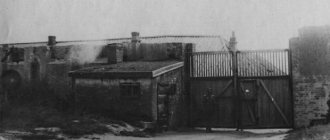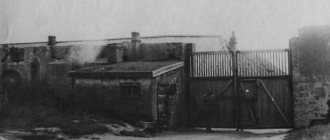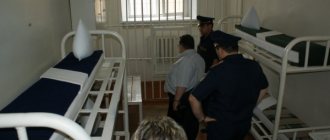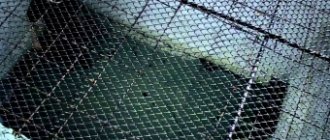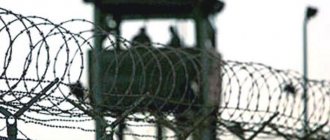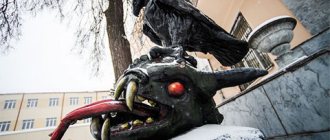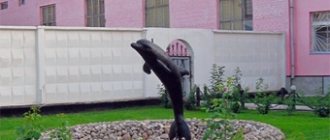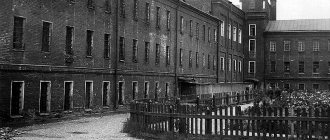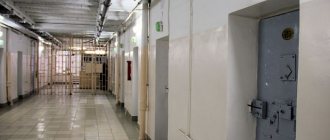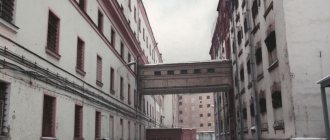On the territory of our country there are several colonies where the most brutal criminals are kept, sentenced to life imprisonment, and most of these places have quite poetic names among the people: Black Golden Eagle, White Swan, Polar Owl...
Information about life behind the walls of these prisons, as a rule, includes a fair amount of fiction due to the closed nature of the institutions. Today we will try to lift the veil of secrecy and tell how the largest colony for those serving life sentences - Black Dolphin - is set up.
Brief description of the most terrible prison in Russia
Federal government institution “Correctional Colony No. 6 of the Office of the Federal Penitentiary Service for the Orenburg Region” - this is exactly the dry and official inscription hanging over the doors of the Black Dolphin.
Where it is located - not far from the border with Kazakhstan, near Orenburg, in Sol-Iletsk - a small town with a population of 27 thousand inhabitants, a couple of engineering and salt mining enterprises and a very arid climate.
The colony owes its name to the figurine of a dolphin that jumps out of a stone fountain located in front of the entrance to the prison. The history of the place of imprisonment and the time prisoners spent there contains many interesting facts and goes back more than one century. Back in the Russian Empire, convicts were sent here to work in salt mines.
The regime for serving a sentence in a colony is defined as special. Living conditions in custody are regulated by Article 127 of the Criminal Executive Code of the Russian Federation. This regime imposes strict requirements for the placement of prisoners and concerns:
- conditions of detention;
- the procedure for spending personal funds;
- the number and types of visits provided;
- parcels, transfers and parcels.
You can learn more about the history of the prison in Sol Iletsk “Black Dolphin” and see the list of prisoners here.
We will consider the features of the punishment serving regime separately. Below are the contact details of the institution and other useful information:
- Postal address : 461530, Orenburg region, Sol-Iletsk, st. Sovetskaya, 6.
- E-mail address
- You can contact the colony leadership not only in writing, but also in person. Reception hours on weekdays from 15.00 to 18.00, visitors are received on a first-come, first-served basis, with veterans and participants of the Great Patriotic War and persons equivalent to them, as well as disabled people of the first and second groups, having the right to an extraordinary reception.
You can contact the following people with questions:
| Full name | Job title | Rank | Reception day |
| Korobov Yuri Petrovich | Acting head of the colony | Lieutenant Colonel of the Internal Service | Monday |
| Sharipov Dmitry Shamilevich | Acting Deputy Chief | Captain of the Internal Service | Tuesday |
| Kandyba Danila Yurievich | Acting Deputy Chief | Major of internal service | Wednesday |
| Ergalieva Elina Aleksandrovna | Head of the medical unit | Lieutenant of internal service | Wednesday |
| Shkondin Vladimir Vladimirovich | Acting Deputy Chief | Major of internal service | Thursday |
| Duvanov Igor Nikolaevich | Deputy Chief (Head of Security Department) | Lieutenant Colonel of the Internal Service | Thursday |
| Startsev Petr Nikolaevich | Deputy Head (Head of Center) | Captain of the Internal Service | Friday |
You can clarify the internal number of the employee you are interested in and decide which personnel you need by calling the reception phone number: 8 (35336) 36-2-08.
Any emergency information - call the duty department: 8 (35336) 36-2-00.
Additional information about the colony can be obtained from the following information resources:
- https://56.fsin.su/structure/detail.php?ELEMENT_ID=4985 – the official page of the institution in the GUFSIN, here, among other things, you can apply for registration of transfer and granting a visit.
- https://vk.com/blackdolphinrus is the largest group on VKontakte, uniting close relatives of Black Dolphin prisoners, lawyers providing legal assistance, and simply caring people. The group is closed, but access from the real page is obtained without any problems.
- https://vk.com/club16985548 – a smaller, open group.
For relatives and close relatives of prisoners, visiting rooms and a point for receiving parcels, parcels and packages operate according to the following schedule:
- 8.00 – 13.00 – applications are accepted from persons who came for a date, parcels and transfers;
- 13.00 – 14.00 - lunch break;
- 14.00 – 19.00 – issuance of parcels, packages and packages.
Parcels are accepted from the central post office every week on Thursdays. In addition, a store is open for relatives of convicts daily from 9.00 to 21.00 (with a lunch break from 13.00 to 15.00).
Description of the species
Black swans became known to Europeans only after the discovery of Australia and Tasmania. This is where this beautiful and exotic bird comes from. After the discovery of New Zealand, black swans came to these islands, where they became incredibly popular in private backyards and parks.
The black plumage of birds has a peculiar moire pattern created by the grayish edging of the outer feather.
Some birds have interspersed white or even black and white feathers. It is very common to find representatives of this species with curled flight feathers and shoulder feathers. The beak is bright scarlet. The feet are most often black or blue-black. The young are distinguished by their grayish-brown feather color and light, often pink, beak.
The black swan is a rather large bird. The weight of individual representatives can reach ten kilograms or more, and the wingspan is about two meters. The body length of females does not exceed 110 cm, males - 150 cm.
Representatives of this species have the longest neck among all their relatives, a neat small head and a short, dense tail. The length and structure of the neck allows it to reach food even from great depths.
Photo of the colony for life sentences in Sol-Iletsk
Next in the photo you can see what the Sol-Iletsk colony for life sentences looks like. Pay attention to the photo of the fountain with a dolphin, thanks to which the colony got its name “Black Dolphin”.
Lifestyle
Despite the fact that birds are excellent flyers, they rarely fly. The warm climate allows black swans to lead a sedentary lifestyle, flying to new feeding grounds only as a last resort.
To take off, they need a large open water space - at least 70 meters. The long takeoff run is explained by the heavy weight and structure of the wings.
Black swans live in large colonies and this makes them different from any other species. Often a colony numbers up to 50 pairs. They are very tolerant of their neighbors and rarely show aggression. Different individuals constantly communicate with each other using loud guttural sounds.
In nature, birds have almost no enemies among animals: they are so strong that they can even drive away a dingo. However, young animals are often hunted by reptiles and birds of prey.
The swans' diet consists of small algae, aquatic vegetation, grass and young shoots of bushes growing near the reservoir. They can also feast on fish fry, small amphibians, crustaceans and invertebrates. A colony of birds prefers to settle near open and non-swampy bodies of water, on the banks of slow-flowing rivers or on the sea coast.
If there are agricultural fields with wheat, corn or barley crops near the nesting site, the birds will raid and eat part of the seedlings and ripened crops.
Who gets there and why?
The colony houses the most dangerous criminals, sentenced to life imprisonment.
This sentence is imposed relatively infrequently in our time and is applied to those who have committed a particularly serious crime.
Murders with extreme cruelty, cannibalism, terrorism, rape of minors - this is not a complete list of acts for which they serve time within these walls. Such a severe punishment is not provided for everyone.
For example, there are no women in the Black Dolphin: for them, life sentences are prohibited by law . Also, such punishment is not provided for persons who committed a crime as minors, and for those who were already 65 years old at the time of sentencing.
Among the prisoners there are also those who were initially sentenced to capital punishment, but were saved (or perhaps, on the contrary, prolonged their torment) on the basis of a moratorium on the death penalty introduced in 1996.
One of the criteria for placement in prison is the increased social danger of both the crime committed and the personality of the defendant himself: recidivism, lack of repentance, motives for the crime play an important role in the decision of the judge and authorized employees of the penitentiary service and can significantly increase the dubious “chances” of spending the remainder of your life right here.
Crosses
The most famous prison on the banks of the Neva. Built at the end of the 19th century, the jail got its name due to its remarkable cruciform body. Only prominent figures and very influential people served sentences in Kresty. In the first years of the prison’s existence, Lev Gumilyov, Joseph Brodsky and a whole list of other notable personalities were imprisoned under the pretext of counter-revolutionary activities. Anna Akhmatova's husband and son were rotting in the dungeons of Krestov. Not far from the prison territory there is a monument dedicated to the poetess, on the slab of which lines from her “Requiem” are engraved, dedicated to the difficult fate of his wife and mother, whose closest and dearest people were imprisoned in the Crosses. After the fall of the Soviet Union, the prison was so overcrowded that small cells held 20 people. Those days are remembered for loud riots among prisoners. Years passed before Kresty was reformed, modernized and received the status of an elite, even with the prefix VIP, prison. Many prominent figures in the criminal world received unprecedented levels of comfort and privilege in prison.
Infrastructure
The institution consists of several buildings for different purposes . The entire perimeter of the area is surrounded by a high fence. With the help of video cameras, constant round-the-clock monitoring of everything that happens within the walls of this prison is carried out. The records are stored for a month, and in the event of emergency situations, employees have the opportunity to track every movement and every action performed in the controlled area.
Most of the premises are allocated directly to the cells in which criminals serve their sentences. In addition to them, on the territory there are:
- specially equipped premises for the work of prisoners who have received such a privilege;
- premises for long visits with relatives;
- administrative department;
- a medical unit equipped with advanced equipment sufficient to provide comprehensive medical care, as well as to diagnose diseases in the early stages;
- premises for utility and auxiliary purposes, incl. enclosures where service dogs are kept;
- a stall where prisoners can order additional products in addition to those provided as the main food in the zone (additional rations are paid from the prisoner’s personal funds - wages or transfers from relatives);
- shop of souvenirs made by local craftsmen.
"A comfortable place for a person to live"
Prison "Snowflake". Photo: Website www.mzk1.ru
The name of the village of Elban in the Khabarovsk Territory in the language of the Ulchi, a small people living in the Lower Amur basin, means “a convenient place for a person to live.” Ironically, it is there that the first and only zone for life prisoners in the Far East is located - correctional colony No. 6 (IK-6). Elban was founded in the mid-30s of the 20th century, during the construction of the Volochaevka - Komsomolsk-on-Amur railway line. Construction work, as often happened at that time, was carried out by convicts from one of the Gulag units.
However, the first zone in Elban - maximum security correctional colony No. 17 (IK-17) - appeared only in 1972. In the early 90s, they decided to convert IK-17 into a pre-trial detention center for 800 people and build a new complex of buildings for this purpose. The isolator design, which meets European standards and all safety requirements, was developed in Sweden in 1992, construction began four years later. Residents of Elban took the news of the opening of a pre-trial detention center in their village calmly: the new detention center promised additional jobs.
True, the construction of the insulator lasted almost 16 years - due to lack of funding, the work was repeatedly frozen. The total amount spent on the pre-trial detention center, according to some sources, was close to 900 million rubles, according to others, it exceeded a billion. An integrated security system was created in the detention center, similar to that at the capital's Domodedovo Airport. In addition, a fire reservoir, its own boiler room and three diesel engines for autonomous power supply in case of power outages were created on the territory of the pre-trial detention center.
Mode
The daily routine in a special regime colony is carefully verified and does not allow the slightest deviation from the established rules:
- 6:00. Climb. Prisoners have about half an hour to wash, tidy up the cell (the cleanliness of the area is maintained on their own) and make the bed in accordance with the requirements, which are quite specific here: the mattress is folded in half along the length of the bed, the edging is beaten - this is done for so that the space can be viewed as much as possible through the bed bars through the peephole, without opening the doors and without employees of the institution entering the cell.
- Breakfast from 6:30
- At 7:15, the electrical sockets in the cells are turned on, and the prisoners can shave - for personal hygiene, only electric razors are allowed to be used; inmates do not have machines with blades for obvious reasons. Also at this time you can boil water and drink tea - of course, if you have such a luxury by prison standards as tea leaves.
- 8:00 – the radio turns off, the morning check begins.
- 9:00 — at the end of the morning check, prisoners with health problems are escorted for a medical examination.
- At 10:00 a walk begins, the duration of which is limited to one and a half or two hours, depending on the behavior of the convicted person. At the same time, the cameras are being searched.
- 13:00 - dinner.
- 13:50 - cleaning cells.
- From 14:00 to 17:00 the radio in the cells is turned on again.
- 18:00 - dinner (40 minutes).
- 20:00 - evening check, the procedure is the same as in the morning.
- 20:30 - Reconnected sockets and radios are available to prisoners.
- 22:00 - lights out. The long-awaited time when you can finally use a bed that has been unavailable throughout the day - from getting up to lights out, convicts are prohibited from going to bed or even sitting in beds.
During the day, the cameras are inspected through the peephole at least every 15 minutes.
Thieves in law in the White Swan colony
Thieves in law who died in prisons and colonies
"White Swan" was created in 1938 as a camp for political criminals. In 1955, the colony was repurposed as a place for the re-education of thieves in law. The name of Vasily Snytserev, a major general who broke authority, is connected with this time period. During the years of his service, five thousand criminals passed through the White Swan: many of them lost their status in the criminal hierarchy, and 130 thieves in law renounced their crown.
They “processed” criminals who considered themselves special using different methods: they were forced to work, and for disobedience they were sent to a detention center; they found a serious illness among the prisoners and entered into an agreement: treatment - after refusing the “corona”; thieves in law were put in so-called “press huts”, where they were dealt with by prisoners supporting the prison administration.
The most famous local thief in law who has not renounced his title is Vasya Brilliant, who ended up in the White Swan after 30 years in prisons and camps. Here, in 1985, shortly after his arrival, he died, according to a medical report, of a heart attack. The grave of the thief in law with a monument in the form of a dome is located in Solikamsk.
“In his (Brilliant’s) times, as it was: the prisoner did not dare to lay a finger on a doctor or teacher, he did not dare to say a bad word to them - this is sacred. And then came the troubled 90s, there was blood and victims everywhere,” said a White Swan employee. — Now is a new stage of the relationship. But the prisoner became completely different, “homey.” Instead of cigarettes - light cigarettes, instead of chifir - tea with bergamot. The inmates take care of themselves, always assert their rights, and demand attentive treatment.”
Diagram of a cell in the White Swan colony. Photo: Alexey Zhuravlev, www.perm.kp.ru
Features of serving a sentence. How do they live there?
Taking into account the special danger of the contingent, additional requirements for conditions of detention have been established in this place of deprivation of liberty. Here are just a few of them:
- The supply of electricity inside the cells is rare and short-lived - this is one of the many safety conditions. There were cases when prisoners, during their rounds, threw a bare live wire onto the bars and thereby injured the guards who touched it. The colony's management takes into account this sad experience, as well as many other cases, and establishes rules that minimize the possibility of harm to employees.
- Before the inspectors enter, those sitting in the cell must take the “swallow pose”: bend low, touching the wall with their foreheads, open their mouths, close their eyes, put their hands behind their backs and spread their fingers. For the uninitiated, this position may seem rather comical, but it is the safest and most convenient for a search. You can’t hide anything in an open mouth, closed eyes don’t allow you to make sharp targeted movements, and splayed fingers don’t allow you to squeeze half a razor blade between them, which was once very popular in prisons during escapes or just brawls: a small cut on the hand is relatively safe, and By slashing the eyes you can permanently incapacitate one or two guards. All the rules here are written in blood. From this position, the prisoner must loudly and clearly state his full name, article number, crime committed and term of punishment. Due to repeated daily repetition, this information is very quickly learned by heart and turns into something like a tongue twister, pronounced automatically. However, institution employees should never forget who they are dealing with and relax. For the same purpose, information about each convicted person and the crimes he committed is posted next to the cell doors.
- Movement outside the cell is carried out in the “swallow pose” described above, in handcuffs. There must be at least three accompanying people from among the colony staff, and the presence of a canine handler with a dog (mainly German shepherds and Rottweilers). Service dogs are not required to be muzzled, and if a prisoner tries to escape, he faces the unpleasant prospect of experiencing first-hand the running speed and sharp teeth of a furry guard. If the convoy is carried out outside one building, a black bandage is put on the convict’s eyes - this prevents him from orienting himself in space and remembering the location of the buildings, which could help in an escape attempt.
- There is no courtyard where you can see the sun and breathe fresh air - walks take place on an area surrounded by a lattice under the roof of the building. During the walk, the cells are searched. At the same time, absolutely everything is inspected, including checking the technical condition of the floor, walls, grilles, wiring and lighting. Each section of the lattice bars is tapped with a special hammer in order to identify signs of an impending escape. Prisoners' clothing is inspected using a metal detector.
- Those kept in the colony have to sleep according to the rules: the position must be such that the face is visible through the peephole of the door, and the hands must be placed on top of the blanket. The lights in the cells are never turned off: especially dangerous criminals require round-the-clock surveillance, and the darkness, so familiar to us during sleep, is an unaffordable luxury for them.
Read our materials about how prisoners live in other terrible prisons of the Russian Federation, namely in: Yeletskaya, FKU IK-5 of the Federal Penitentiary Service of Russia (Vologda Pyatak), Butyrskaya, FKU T No. 2 of the Federal Penitentiary Service of Russia in the Vladimir Region (Vladimir Central), FKU “Pre-trial detention center-1” of the Federal Penitentiary Service in St. Petersburg (Pre-trial detention center Kresty), FKU SIZO-1 of the Federal Penitentiary Service in Kolpino (New Crosses), Snezhinka, FKU SIZO-1 of the Federal Penitentiary Service in Moscow (Matrosskaya Tishina) and Lefortovo.
Punishment cell
For violation of the rules of behavior in a maximum security colony, liability is provided in the form of placement in a punishment cell with deprivation of the few benefits that are available to those who comply with the regime. The difference between this one and the isolation ward in other places of deprivation of liberty is that they are placed there individually. Of the amenities, only the bare minimum is available: a rough-hewn plank bunk, the mattress for which is provided only at night, and a washbasin with a toilet.
To get into a punishment cell, you need to, in a sense, “try” - this measure does not apply to everyone. In case of violation of discipline, the convict is first given a verbal reprimand, then a conversation is held, then a reprimand is entered into the personal file, and only if there is no positive effect after all these measures, the prisoner can be removed to the punishment cell.
At all stages of the application of punishment, employees of a psychological laboratory work with convicts , who analyze the situation, monitor changes in the behavior of the offender and determine the advisability of applying a particular punishment in each specific case.
Nutrition
There is no dining room for special regime, so meals are taken cell by cell. To ensure the safety of staff, plates of food are pushed into the cell through a window in the door on a special paddle with a handle more than a meter long. At the same time, the prisoners are briefly turned on to the radio.
Speaking of culinary delights: minimum standards have been established in accordance with which food for prisoners is prepared - according to the Decree of the Government of the Russian Federation of April 11, 2005 N 205 “On minimum standards of nutrition and material and living support for prisoners sentenced to imprisonment ...” it is mandatory to comply with scientifically based physiological norms of human nutrition.
Translated into simple language, this means the following composition of the average menu for the day:
- 550 g bread;
- 100 g of cereals of different types and fish;
- 30 g pasta;
- half a kilo of potatoes and 250 g of vegetables;
- 90 – meat and 30 – poultry;
- 20 g vegetable oil and 35 margarine;
- a couple of chicken eggs a week.
In addition, provision is made for the provision of sugar, salt, bay leaves and tea, dry fortified jelly or dried fruits. Hot food is also required.
Transfer rules
A prisoner has the right to four parcels or transfers per year (depending on the regime of stay, if the regime is normal, then more). The list of things and products acceptable for transfer is strictly regulated, and in order to slightly ease the share of relatives, there is a store on the territory of the MLS.
Here you can purchase products necessary for transfer, which meet all the requirements of the institution and do not require inspection, unlike things brought from the “mainland”, which are carefully inspected before being transferred to the prisoner, often violating the integrity in search of things hidden inside that are prohibited for transfer.
Living conditions
The situation in the prison is spartan. Small cells are built at the rate of 4.5 square meters of space per person. There is a metal two-story bed against one wall, a table with a bench against the other, and a latrine without doors or the ability to close in the corner.
The walls and floor are predominantly white and light blue - it is believed that such colors promote calm and reduce aggression, which is extremely important for such specific prisoners as the prisoners of this colony.
There is an additional grille inside the room that limits access to windows and doors. Also, to prevent escape, the cameras are located no lower than the second floor to eliminate the possibility of undermining.
Mostly there are two people in the cells . You can move to “solitary” for two reasons: special danger and extreme degree of mental instability of the prisoner, which can negatively affect others, and the petition of the prisoner himself. Pairs are selected carefully, taking into account the results of observations and analysis of the psychological compatibility of cellmates.
The convicts themselves are engaged in sewing clothes for themselves - from among those who received the right to work. The prisoners' clothing has a special shape and is made of dark-colored material with bright white stripes - this is done so that in the event of an escape, the regime violator can be easily identified. Slip-on shoes: In the right hands, a simple rope can be quite dangerous.
The requirements for cleanliness here are quite high: maintaining hygiene conditions reduces the risk of the spread of infectious diseases among prisoners and staff. The opportunity to wash is provided once a week in a separate room.
Job
The work of convicts is organized taking into account the requirements of keeping convicts in cells. Only some prisoners who have proven themselves to be exemplary and have spent enough time away from freedom are given the right to work.
The labor process is organized in separate chambers where workplaces and necessary equipment are located. They mainly do sewing, but not so long ago they started making souvenirs, which are in great demand. Part of the proceeds can be used at your discretion - to purchase permitted food products, for example.
In addition, the money earned goes to pay off the claims of the victims and to help relatives left behind the walls of the prison. According to unofficial data, the institution's annual income from the sale of manufactured products is about 5-6 million, which is used to improve living conditions in the colony.
Working with the local contingent is perceived more as an encouragement than as forced labor, because it is an opportunity to change activities, communicate with fellow sufferers and while away another endless day of many to come.
Entertainment and relaxation
Some types of board games are available to prisoners as a leisure activity . There are no maps in the colony, as well as other devices for spending free time with excitement. Chess is also prohibited due to the presence of sharp corners on the pieces and the possibility of using them to harm yourself or fellow inmates. But there is an opportunity to play checkers.
It is also possible to watch TV - more precisely, recorded and carefully selected video programs that do not contain elements of violence and eroticism. In addition, prisoners have at their disposal a library containing both classical literature and works of modern authors - of course, also checked for the potential to harm those on the path of correction.
In general, censorship in the colony is quite strong . As the former head of the colony, Sergei Baldin, noted in one of his interviews, not every letter will fall into the hands of a life-sentenced person, so when corresponding you should not write too much if you want the letter to be read.
Studies
Recreation with benefit to the mind is also available: some, while in prison, manage to obtain a higher education. Most often, diplomas are defended in the criminal area of jurisprudence - part-time students hope that the education they receive will help them be released quickly. Education is obtained both in the library from books and using the Internet. Exams are also taken remotely.
Religion
Believers have the opportunity to perform religious activities . The prayer room is unusual to the eye of a simple free citizen, and security requirements also apply to it: a bright light is on, a conversation with a religious minister takes place through bars, one of the convict’s hands is handcuffed to the bars at this time. The left one - after all, the right one needs to be baptized.
In 2021, an Orthodox church was opened at the colony, and some of its regular visitors from among the prisoners even paint icons to decorate the interior of the spiritual sanctuary.
Metropolitan Veniamin of Orenburg and Saraktash, invited to consecrate the place for prayers of the condemned, is convinced that the Orthodox Church should provide all possible support to people who have stumbled. According to the management of the institution, joining the faith helps criminals realize their guilt, repent and learn to live by different rules.
Dating
The special regime and specific nature of the place of deprivation of liberty implies stricter visiting rules. During the first ten years, prisoners are entitled to only two short-term visits per year and one long-term visit per year, and only with immediate relatives - children, parents, legal spouses. For long meetings, almost hotel-type premises are provided .
Sailor's silence
The name of the prison is due to its territorial location. In the past, even under Peter I, this area of Moscow was inhabited by workers from factories producing canvas, thick cotton, supplied for the navy of the Russian Empire under construction. Nearby were the residences of sailors who received serious injuries during legal proceedings and military campaigns. The combination of all the above facts was reflected in the immediate name of the prison: the name of the street plus the symbol of the almshouse in the form of the word “silence”. Prisoners with special status serve their sentences in this prison. For example, Khodorkovsky, who was recently released, served his sentence here. The legendary Sergei Mavrodi has become a real symbol and synonym of Sailor's Silence. And many other economic and political criminals were and remain prisoners of this prison.
Mentions in popular culture and interesting facts
The specific “romance” of the Black Dolphin has left its mark on modern Russian culture. There are many documentaries (“Journey to a Model Prison” by V. Mikeladze) and feature films (“Game. Revenge”) films that clearly illustrate the living conditions and describe the fates of the people staying here. There are also references in music: Andrey Ermakov and Gio Pica have in their repertoire songs of the same name “Black Dolphin”.
Foreign researchers are also interested in this place of detention. For example, the National Geographic film crew, as part of one of their many projects, shot a documentary film entitled: “A View from the Inside. The most terrible prison in Russia" (Inside. Russia's Toughest Prisons)
CHARACTERISTIC FEATURES OF THE BLACK SWAN
Plumage: black. The ends of the feathers on the shoulders are beautifully curled. During flight, the white flight feather is clearly visible.
Beak: large, orange-red, with a white stripe at the tip.
Eggs: The female lays 4-10 light green eggs at 12-24 hour intervals.
— Habitat of the black swan
WHERE DOES IT LIVE?
This bird is native to Australia. In 1864 it was introduced to New Zealand, where it became quite numerous in the North and South Islands. The black swan was brought to Europe as an ornamental bird.
PROTECTION AND PRESERVATION
Now the black swan is gradually returning to those areas where it was previously exterminated. He is under guard.
Famous prisoners
The Black Dolphin contains many participants and organizers of high-profile crimes . Here are just a few from the huge list:
- Cannibal Nikolaev Vladimir Nikolaevich, born in 1959, is one of the most famous criminals held in the colony. In 1997, he killed and ate two people, shared the meat with a friend, whose wife made dumplings from “kangaroo meat” and fed the whole family. He was sentenced to death, but in 1999 the sentence was changed to life imprisonment.
- Kostarev Oleg Vladimirovich, born in 1986 , a member of the terrorist organization “SPAS”, in 2006 he staged the infamous explosion at the Cherkizovsky market, which injured several dozen people. In 2008 he was sentenced to life imprisonment.
- Melyukh Andrey Fedorovich, born in 1977 , is considered one of the most terrible criminals in the Urals, in order to enrich himself he committed a series of brutal crimes, in 2002 he was sentenced to serve a life sentence.
- Evsyukov Denis Viktorovich, born in 1977 - former head of the internal affairs department, in 2009, while intoxicated, he fired at a Moscow supermarket, as a result of which seven people were injured and two were killed.
Guests from "Black Golden Eagle"
Residential block of the Snezhinki prison building. Photo: Website www.mzk1.ru
The insulator received its unusual name - “Snowflake” - due to the fact that its buildings are arranged in the shape of a seven-pointed star. The pre-trial detention center was inaugurated at the end of January 2015, although it was put into operation back in 2012. “Snezhinka” operated as a detention center for only two years, and its occupancy rate with prisoners never exceeded eight percent of all places. As a result, they decided to repurpose the unused pre-trial detention center into IK-6, a special regime zone for those sentenced to life terms.
Today “Snezhinka” is designed for 378 “life prisoners”, who can be accommodated in 144 cells; they are located in the second, third and fourth blocks of the zone. In fact, there are 250 life prisoners in IK-6. The first 23 of them arrived in Elban on September 20, 2021 - before that they were in the famous Black Golden Eagle colony in the Sverdlovsk region, which they decided to close.
The convicts were traveling in stages through the Irkutsk pre-trial detention center, and some of them, barely reaching Elban, hastened to write complaints about ill-treatment in the detention center. The prisoners were outraged that they were led around the territory of the Irkutsk detention center in handcuffs and with guard dogs. Those sentenced to life considered these measures unnecessary and even torture, because in the Black Golden Eagle they were distinguished by exemplary behavior. True, an audit carried out on the basis of complaints from convicts confirmed that all the security measures that were applied to prisoners in the pre-trial detention center were appropriate.
Reproduction
Swans form pairs at the age of two to three years and remain faithful to their partner throughout their lives. The breeding season begins with the arrival of rains: this is due to a rise in water levels and an increase in the amount of food. The mating season begins with beautiful dances: one of the partners spins, gracefully shaking his neck and showing off his plumage. When the second partner joins the game, both birds begin to move in sync, stretching their necks, spreading their wings, and swimming. Usually the dance lasts no more than half an hour and ends with mating.
Both partners take part in the construction of the nest. The nest is built from stems, leaves, dry grass and fluff. Most often they choose a place in shallow water or at the very edge of the water. If there is an abundance of food, the pair will use one nest for several years. There are usually no more than seven eggs in a clutch. The incubation period is one and a half months.
Both the male and the female incubate the eggs. For the first two days, the chicks remain in the nest.
On the third day, they follow their parents in search of food, and spend almost all their time on the water. The young begin to fly on the wing after the first adult molt - at four to five months, and remain with their parents until the next breeding season.
